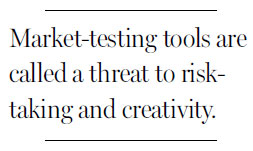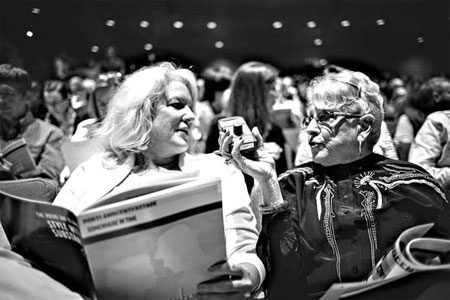Fate of a musical in the crowd's hands
Updated: 2013-07-07 08:34
By Patrick Healy(The New York Times)
|
|||||||||
|
Dial testing, common in politics, television and music, has now arrived in the theater. In Portland, Oregon, audience members register their opinions. Leah Nash for The New York Times |

PORTLAND, Oregon - Seven minutes into his new musical, "Somewhere in Time," the Broadway producer Ken Davenport leapt off his stool and began pointing. Not at the stage, but at a nearby laptop that showed - in a fever-chart line - the reactions of 60 audience members as they turned hand-held dials among three choices: "Love this part," "Neutral about this part" and "Hate this part."
The dials seemed to pinpoint a problem with the song "Tick Tick Tick": the fever line slid as the main character, Richard, lamenting the rush of life, was interrupted by dry dialogue from his brother.
"The dials matched my instincts," Mr. Davenport said during intermission at Portland Center Stage here, where he was trying this system for the first time for the musical's world premiere. "By the time we get the show to New York, I bet we'll drop that dialogue."
Thus dial testing, common in politics, television and movies, has now arrived in the theater. The very idea of it is raising questions in the industry about what makes good theater.
"Did Beethoven ask, 'Was the second movement too dull?' This is scary. Do we want to test-market Broadway until it becomes a theme park?" said Emanuel Azenberg, a producer for 45 years.
Focus groups and audience surveys are increasingly part of theater already, to the distress of some producers like Mr. Azenberg, who see them as crutches that lead to simplistic shows. Several producers said dials were the enemy of groundbreaking work.
Others, like Sue Frost, who used focus groups on her show "Memphis" - which won the best musical Tony in 2010 - were intrigued but skeptical that dials would catch on among Broadway producers because the technology might make audiences "so hypercritical that you get more data and opinions than are useful."
"I also believe that I can tell a lot by standing in the back every night and listening to the audience," she added. "You know when they're bored, when a song is going too long."
This old-school approach - relying on eyes and ears - evokes the era of auteur-producers like David Merrick and Harold Prince, who began new musicals out of town and compiled fix-it lists based on their aesthetic sensibilities, the body language of audiences and feedback from friends and critics. The reality of Broadway today is that 75 percent of shows lose money.
"Why not use dials and every other tool possible to create more musicals that please audiences and turn a profit?" said Damian Bazadona of Situation Interactive, a marketing company that works on Broadway shows.
Frank Luntz, a Republican consultant who pioneered dial-testing in political messaging and also has done dial-testing for TV shows, said the feedback did not guarantee success "but oftentimes can prevent failure."
"I'm a little surprised Broadway is doing this, to be honest," he added. "Producers have a vision in their head, and they don't want the masses affecting or impacting that vision."
Mr. Davenport said the dials were guidance, not a veto, for his judgment about "Somewhere in Time," based on a 1980 film about a playwright who travels back through the years to pursue a romance with an actress. The movie, which starred Christopher Reeve, had bad reviews but earned fans, particularly among women - leading Mr. Davenport to view "Somewhere in Time" as a pretested brand that might appeal on Broadway, since two-thirds of audiences there are female.
Over three performances of dial-testing, no single song bombed, but parts of songs and scenes caused consistent dips in the fever line. One musical number that received the show's highest dial score - 80 out of a possible 100 - was "A Trip to the Grand," which delivered ballroom choreography and lavish period costumes, the sort of big production number that musical traditionalists love.
"This Portland production cost $1 million, and our Broadway production will cost $10 million, but that score of 80 tells me that maybe ours should cost $11 million," Mr. Davenport said. "Maybe another $1 million could get us to 90 in that number."
The New York Times
(China Daily 07/07/2013 page12)
